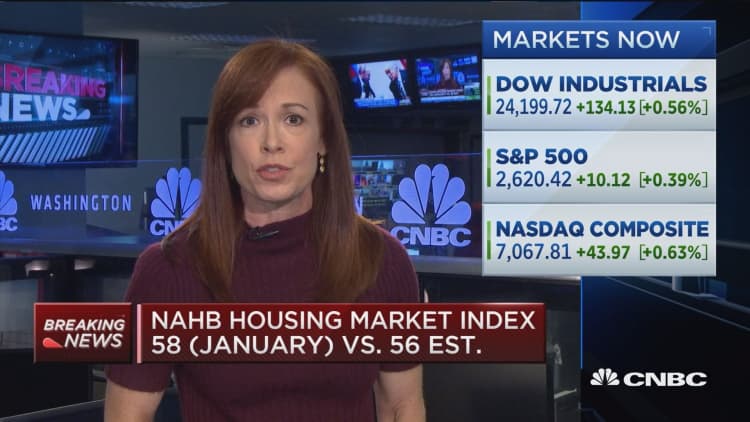Mortgage demand continues to recover sharply, after ending last year in the basement.
Total mortgage application volume rose 13.5 percent last week, compared with the previous week, according to the Mortgage Bankers Association's seasonally adjusted index.
That is its highest level since February and came after a 23 percent jump the previous week. Volume was just 0.5 percent lower than a year ago.
Refinance demand drove the gains, with those applications rising 19 percent for the week to the highest level since March. Volume was 11 percent lower than a year ago, when mortgage rates were 42 basis points lower.

The drop in mortgage rates over the past two months has given new life to the refinance market. Still, it is also important to note that a jump in mortgage rates last January caused mortgage demand to drop, so the annual comparisons are now off a lower volume. Refinance volume is still historically low.
The average contract interest rate for 30-year fixed-rate mortgages with conforming loan balances ($484,350 or less) remain unchanged at 4.74 percent, with points decreasing to 0.45 from 0.47 (including the origination fee) for 80 percent loans. The rate has fallen 20 basis points in the past four weeks.
"Uncertainty regarding the government shutdown, slowing global growth, Brexit, a more patient Fed and a volatile stock market continued to keep rates from increasing," said Mike Fratantoni, MBA's chief economist. "The spring homebuying season is almost upon us, and if rates stay lower, inventory continues to grow, and the job market maintains its strength, we do expect to see a solid spring market."
Mortgage applications to purchase a home also rebounded 9 percent for the week to the highest level since April 2010. Purchase volume was 11 percent higher than a year ago. Buyers may be jumping in before the start of the usually competitive spring season. They may also be eager to take advantage of the dip in mortgage rates. More inventory came onto the market at the start of the year, and that may also be adding to activity.
The refinance share of mortgage activity increased to its highest level since January 2018, 46.8 percent of total applications, from 45.8 percent the previous week, and the adjustable-rate mortgage share of activity increased to its highest level since October 2014, 9.2 percent of total applications. The average loan size for refinance applications reached a survey high at $353,100.
"Borrowers with larger loans tend to be more responsive to a given drop in mortgage rates, and we are seeing that so far in 2019," Fratantoni said. "Furthermore, borrowers with jumbo loans are also more apt to take adjustable-rate mortgages as opposed to fixed-rate loans. Thus, it is not surprising to see the ARM share at its highest level since 2014. These borrowers may also feel more confident taking an adjustable-rate mortgage given the expectation of a more patient Fed."
Although it is just one week's read, the jump in purchase demand bodes well for the start of the spring market, indicating strong demand. High home prices were sidelining buyers last spring, and higher mortgage rates last fall only exacerbated the weakness. Both Wells Fargo and J.P. Morgan reported lower mortgage origination volume in the last quarter, according to company earnings releases Tuesday.
"Home Lending revenue was down 8 percent, driven by lower net reduction revenue in a low volume highly competitive environment," J.P. Morgan CFO Marianne Lake said in a statement to analysts.
Simply put, banks are making less money on lower mortgage volume and less profitable loans.



